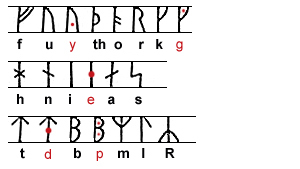Benutzer:Alexander Leischner/Runologie
Zur Navigation springen
Zur Suche springen

Das jüngere Futhark mit 16 Zeichen. Oben Langzweig-, unten Kurzzweigrunen. 
Das jüngere Futhark mit den durch die Punktierung entstehenden Zeichen.


Kopiervorlagen[Bearbeiten | Quelltext bearbeiten]
- ᚠ ᚡ ᚢ ᚣ ᚤ ᚥ ᚦ ᚧ ᚨ ᚩ ᚪ ᚫ ᚬ ᚭ ᚮ ᚯ ᚰ ᚱ ᚲ ⌃ ᚳ ᚴ ᚵ ᚶ ᚷ ᚸ ᚹ ᚺ ᚻ ᚼ ᚽ ᚾ ᚿ ᛀ ᛁ ᛃ ᛄ ᛅ ᛆ ᛇ ᛈ ᛉ ᛊ ᛋ ᛌ ᛍ ᛎ ᛏ ᛐ ᛑ ᛒ ᛓ ᛔ ᛕ ᛖ ᛗ ᛘ ᛙ ᛚ ᛛ ᛜ ᛝ ᛞ ᛟ ᛠ ᛡ ᛢ ᛣ ᛤ ᛥ ᛦ ᛧ ᛨ ᛩ ᛪ ᛫ ᛬ ⁝ ⁛ ᛭ ᛮ ᛰ ࿕ ࿖
- Älteres Futhark
- ᚠ ᚢ ᛟ ᚦ ᚨ ᚱ ᚲ ᚷ ᚹ ᚺ ᚾ ᛁ ᛃ ᛇ ᛈ ᛉ ᛊ ᛏ ᛒ ᛖ ᛗ ᛚ ᛜ ᛞ ᛟ
- Interferenz Sonderformen niederrheinische Epigraphik
- Ⱶ
- Θ
- Đ
- Jüngeres Futhark
Rune inventory[Bearbeiten | Quelltext bearbeiten]
| Image | UCS | Name | Name meaning | Transliteration | IPA |
|---|---|---|---|---|---|
| Vorlage:Runic | feoh | wealth, cattle | f | /f/, [v] (word-medial allophone of /f/) | |
| Vorlage:Runic | ūr | aurochs | u | /u(ː)/ | |
| Vorlage:Runic | þorn | thorn | þ | θ, ð (word-medial allophone of /θ/) | |
| Vorlage:Runic | ōs | god, or mouth (Latin)[1] | o | /o(ː)/ | |
| Vorlage:Runic | rād | riding | r | /r/ | |
| Vorlage:Runic | cēn | torch | c | /k/, /kʲ/, tʃ | |
| Vorlage:Runic | gyfu | gift | g | /ɡ/, ɣ (word-medial allophone of /ɡ/), /j/, /x/?, /gʲ/? | |
| Vorlage:Runic | ƿynn | mirth | w | /w/ | |
| Vorlage:Runic | hægl | hail (as in "precipitation") | h | /h/, x, ç (allophone of /x/ before and after frontal vowels) | |
| Vorlage:Runic | nȳd | need (as in "plight") | n | /n/ | |
| Vorlage:Runic | īs | ice | i | /i(ː)/ | |
| Vorlage:Runic | gēr | year (as in "harvest time"?) | j | j | |
| Vorlage:Runic | ēoh | yew-tree | ï, ʒ | /i(ː)/? /x/, ç (allophone of /x/ before and after frontal vowels) | |
| Vorlage:Runic | peorð | (unknown) | p | /p/ | |
| Vorlage:Runic | ilx | elk's | x | /ks/ | |
| Vorlage:Runic | sigel | sun (but rune poem implies "sail") | s | /s/, [z] (word-medial allophone of /s/) | |
| Vorlage:Runic | Tī, Tīr | Tiw? Mars?[2] | t | /t/ | |
| Vorlage:Runic | beorc | birch-tree | b | /b/ | |
| Vorlage:Runic | eh | steed | e | /e(ː)/ | |
| Vorlage:Runic | mann | man | m | /m/ | |
| Vorlage:Runic | lagu | lake (as in "body of water") | l | /l/ | |
| Vorlage:Runic | Ing | Ing (Ingui-Frea)? | ŋ | /ŋg/, /ŋ/ | |
| Vorlage:Runic | ēðel | ethel (homeland, estate) | œ | /ø(ː)/ | |
| Vorlage:Runic | dæg | day | d | /d/ | |
| Vorlage:Runic | āc | oak-tree | a | /ɑ(ː)/ | |
| Vorlage:Runic | æsc | ash-tree | æ | /æ(ː)/ | |
| Vorlage:Runic | ȳr | yewen bow? | y | /y(ː)/ | |
| Vorlage:Runic | īor | beaver?[3] eel? | N/A | /i(ː)o/? | |
| Vorlage:Runic | ēar | grave soil? | ea | /æ(ː)ɑ/ |
The sequence of the runes above comes from the surviving modern copy of the Anglo-Saxon rune poem which was based on the now-destroyed Cotton Otho B.x.165 manuscript. The first 24 of these runes directly continue the elder futhark letters, and do not deviate in sequence (though ᛞᛟ rather than ᛟᛞ is an attested sequence in both elder futhark and futhorc). The next 5 runes represent additional vowels (a, æ, y, io, ea), comparable to the five forfeda of the ogham alphabet.
While the rune poem and some manuscripts present ᛡ as "ior", and ᛄ as "ger", epigraphically both are variants of ger. R. I. Page designated ior a pseudo-rune.[4]
| Image | UCS | Name | Name meaning | Transliteration | IPA |
|---|---|---|---|---|---|
| Vorlage:Runic | calc | chalk? chalice? sandal? | k | /k/ | |
| Vorlage:Runic | (unknown) | (unknown) | k̄ | /k/ | |
| Vorlage:Runic | gar | spear | ḡ | /g/, [ɣ] (word-medial allophone of /g/) | |
| Vorlage:Runic | cweorð | (unknown) | q | /k/? (for writing Latin?) | |
| Vorlage:Runic | stan | stone | N/A | /st/ | |
| N/A | (unknown) | (unknown) | ę, ᴇ | /ǝ/? | |
| N/A | (unknown) | (unknown) | ᶖ | /e(ː)o/? /i(ː)o/? |